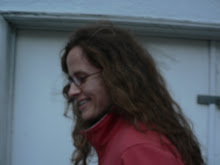
I recently slowed down while reading Radioactive by Lauren Redniss. The book is part biography of Marie Curie, the story of radioactivity, and art book. Did you know Curie was from Poland? Her real name was Marya.
You can smell the ink as you turn the pages. You know how it will all end, that Marie Curie changed science forever, that it killed her, that it continues to be dangerous. To tell the story Redniss created a delightful typeface, which gives the book the appearance of being written by hand, a re-telling in a very physical sense. She named the typeface after Eusapia Palladino, who held seances Marie and Pierre Curie attended. The story of someone's life is never a simple one and Redniss elegantly balances many components of Marie Curie's professional and personal history. The one of scientific discovery. Marie Curie: "It was obvious that a new science was in the course of development." The one of love. The one of triumph. (Marie Curie was named the first female professor to teach at the Sorbonne). The one of atomic properties. How they glowed at night. Their poisonous effects.
Throughout the book I was very attached to the idea of a blurred line between science and magic. Because Radium glowed, Marie Curie was awed by it. In the lab, it was something special. Curie wrote, "If a radioactive substance is placed in the dark in the vicinity of the closed eye or of the temple, a sensation of light fills the eye." In this context, seeking atomic energy and creating it, at least for the Curies, was spiritual. Mystical fusion was the thing that sort of kept them going. In Radioactive, Radium has nearly three sides: the mystical glowy side, the toxic side, and the healing one. It's still used as a cure for cancer. Even though exposure to it is so incredibly harmful. Pierre Curie died so young. Marie Curie followed. Her daughter and grandchildren also died of complications related to radiation exposure.
So are we supposed to celebrate the discovery of Radium or not? Are we supposed to answer? Redniss's book delicately and pointedly addresses the art of art, of pursuit, how earthly things seem so unearthly. Non-fiction doesn't have to be boring or terrible and Redniss's unique and investigative technique of conveying biography makes this book sit well with writers such as Dava Sobel, Rick Pearlstein, Lawrence Weschler, and Karen Elizabeth Gordon. I recommend reading this one slowly.



